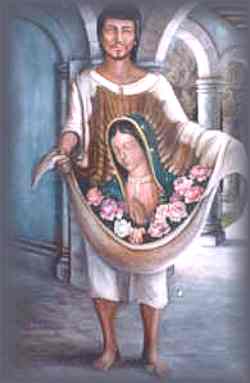Roses in December: Our Lady of Guadalupe
by Felipe de Ortego y Gasca
Share
o
r more than 475 years Mexicans and their progeny around the globe have been celebrating the appearance of Our Lady of Guadalupe to Juan Diego at Tepeyac–near Mexico City–on December 12, 1531. Accounts of that appearance have varied over the years, but essentially the story is that on his way to seek Bishop Zumarraga’s help in healing his sick uncle, Juan Diego, indio, encountered a woman enroute dressed in blue gossamer studded with stars who called him by name.
F
Surprised, Juan Diego listened to her charge that he ask the Bishop to build a church on the site where she stood. Dutifully, Juan Diego related the message to the skeptical Bishop who explained that he needed a sign of some sort from the lady in blue in order to carry out her request. Upon hearing Juan Diego’s account of his conversation with the Bishop, la Virgin de Guadalupe (as she has come to be called) instructed Juan Diego to gather some roses from nearby which he did, placing them in the fold of his tilma.
Carrying the roses to the Bishop, Juan Diego is greeted by Bishop Zumarraga with words of incredulity, “Roses, roses in December–this is the sign?” The Bishop was expecting something more ethereal, failing to realize that roses do not bloom in the mountain heights of Mexico in December.
Taken aback, Juan Diego dropped the hold on his tilma and the roses fell to the floor whereupon the Bishop and those attending him dropped to their knees. Startled by the actions of the clerics, Juan Diego could not see the image of the Virgin of Guadalupe which had embedded itself on the surface of his tilma. That was the sign. The Bishop promptly built a cathedral to honor the lady in blue, and from that time on the madonna of Tepeyac has become the national religious symbol of Mexico. The tilma is on display at the Basilica in Tepeyac.
e
M
xicans of all faiths acknowledge Guadalupe as the patron saint of Mexico. In our house when I was growing up in San Antonio, Texas, my mother kept a home altar for la Virgin de Guadalupe. That altar kept us reverential when we were in its presence. Her picture hung prominently on the wall above the alter, next to the picture of President Franklin D. Roosevelt who with the help of Guadalupe got us through the hard times of the Depression. As a Marine during World War II, the picture of Guadalupe in my wallet kept me confident that she would keep me from harms way. Even later, as a grown man I clung to that childhood belief in Guadalupe. For years my wife and I have kept a statuette of the Virgin in our home.
o
H
wever, what has sustained my spiritual bond with Guadalupe is the play I wrote about her in 1981at the request of Arch-Bishop Patrick Flores of San Antonio to commemorate the 450th anniversary of her appearance to Juan Diego. The title of the play is Madre de Sol / Mother of the Sun, set within the first dozen years of Spanish rule in Mexico starting with the encounter of Moctezuma and Cortez in 1519. The play premiered at Assumption Seminary in San Antonio in September of 1981 and ran until December 12th of that year. At the direction of the Arch-Bishop, Osvaldo “Ozzie” Rodriguez, from the La Mama Theater in New York, was invited by Father Virgilio Elizondo to direct the play. Henry Cisneros’ brother George wrote the music for the play. John Igo, drama critic for the San Antonio Light, gave the show a rave review. After his role in Madre del Sol, Jesse Borrego went on to star in the tv production of Fame and then a success-ful movie career.
In February of 1982, the Arch-Bishop of Mexico City invited us to mount the play at the Teatro Antonio Casso in Tlatelolco. Mrs. Portillo, wife of the president of Mexico, introduced the play to the first audience of its Mexican run. The following year, in 1983, with the help of the Meadows Foundation and the Conference of Christians and Jews, Madre del Sol was staged in Dal-las. The last production of Madre del Sol was mounted by Ozzie Rodriguez at the La Mama in 1984.
For me, the challenge of Madre del Sol was creating it as a trilingual play – English, Spanish, and Nahuatl–engendering comments from both English-language and Spanish-language audiences that despite its linguis-tic structure, they understood every word in the play.
As we approach the 500th anniversary of Guadalupe’s appearance to Juan Diego on that felicitous day of 1531, one wonders about the celebratory homage of the 500th Anniversary. Perhaps roses will bloom where least expected–and in December.
Copyright © 2007 by the author. All rights reserved.
We hope you enjoyed Ortego's article. As today is also Gaudete Sunday, here's the musical piece from the Piae Cantiones.












No comments:
Post a Comment